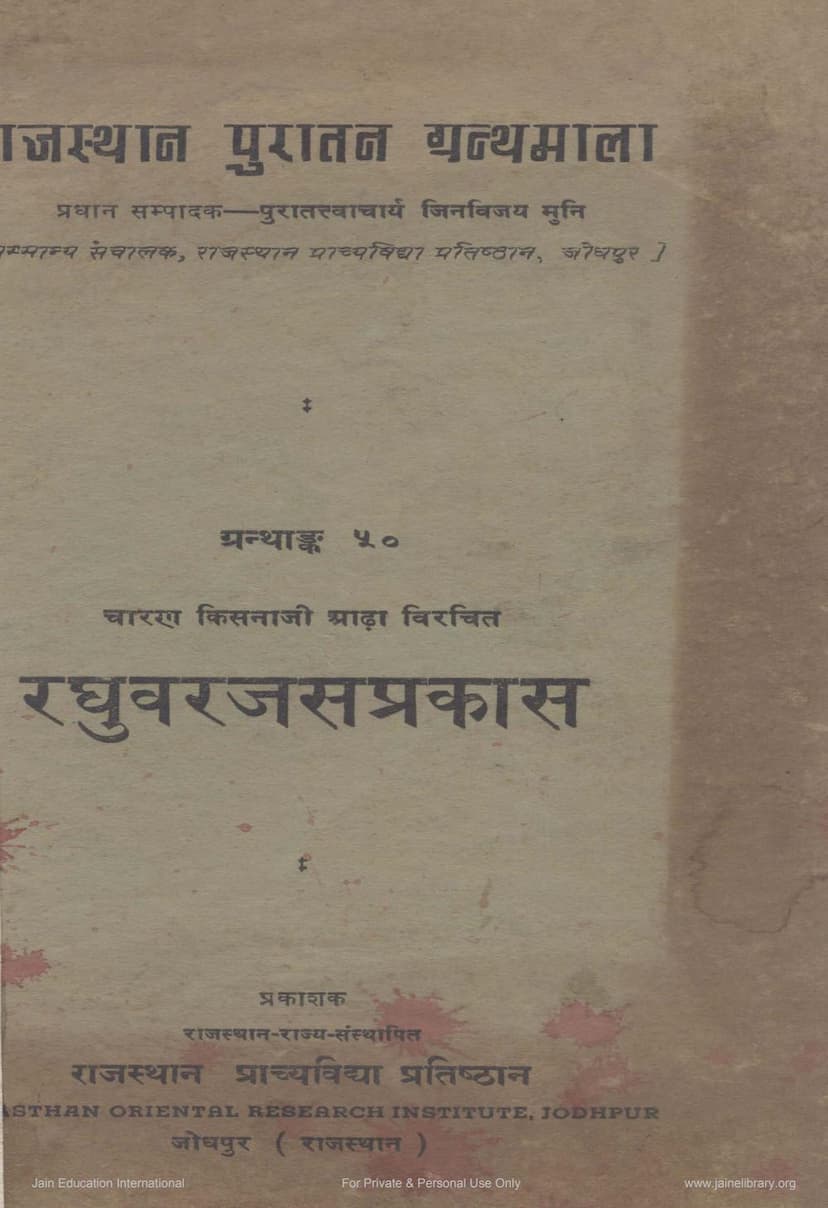Raghuvarjasa Prakasa
Added to library: September 2, 2025

Summary
Here's a comprehensive summary of the Jain text "Raghuvarjasa Prakasa," based on the provided pages:
Title: Raghuvarjasa Prakasa Author: Charana Kisnaji Āḍhā Editor: Sitaram Lalas Publisher: Rajasthan Prachyavidya Pratishthan, Jodhpur Publication Year: Vikram Samvat 2017 / Saka Era 1882 / 1660 AD
Overview:
"Raghuvarjasa Prakasa" is a significant work in the field of Rajasthani (Dingal) prosody and literary criticism. It was compiled by the renowned poet Kisnaji Āḍhā, who hailed from a distinguished lineage of Charan poets, being a descendant of the celebrated poet Durṣāji Āḍhā. The work was published by the Rajasthan Oriental Research Institute, Jodhpur, as part of the "Rajasthan Prachya Granthamala" series. The primary aim of the book is to explain and illustrate the various metrical rules and patterns prevalent in Rajasthani poetry, particularly focusing on the intricate system of "Gīt" (songs).
Key Themes and Content:
-
Introduction to Rajasthani Prosody: The book delves into the evolution of metrical science, tracing its roots from Sanskrit literature through Prakrit and Apabhramsa to its development in the Rajasthani language (also known as Dingal). It highlights the importance of prosody in shaping the beauty and structure of poetry.
-
Detailed Analysis of Metrical Forms: "Raghuvarjasa Prakasa" meticulously describes various metrical forms used in Rajasthani poetry. This includes:
- Varnavritta (Syllable-based meters): The author enumerates and explains meters based on the number of syllables per line, from one to twenty-six, drawing upon Sanskrit traditions.
- Matrika Chanda (Mora-based meters): The text extensively covers meters regulated by the number of moras (units of vowel length). It presents detailed rules for various matrikas.
- Gīt (Songs): A significant portion of the book is dedicated to the explanation of the "Gīt" form, which is considered a unique and original contribution of Rajasthani literature. The author elaborates on the characteristics, types, prosodic rules, common errors, and significant aspects like "Vanasagai" (alliteration patterns) within Gīt compositions. The text discusses eleven types of Gīts and their specific rules, which is a notable feature of this work.
-
Literary and Linguistic Significance:
- Onomatopoeia and Visual Poetry: The book touches upon aspects of "Chitra Kavya" (visual poetry or patterned verse) and provides examples like "Kamalbandh" and "Chatrabandh," showcasing innovative metrical arrangements.
- Praise of Lord Rama: While explaining the metrical rules, Kisnaji Āḍhā interweaves devotional verses in praise of Lord Rama. This dual purpose of expounding prosody and glorifying Rama is a hallmark of his poetic style.
- Author's Lineage and Patronage: The preface and introduction provide biographical details about Kisnaji Āḍhā, highlighting his lineage from the renowned poet Durṣāji Āḍhā. It also mentions his scholarly prowess in Sanskrit, Prakrit, Brij Bhasha, and Rajasthani, and his patronage by Maharana Bhim Singhji of Udaipur, who even granted him a village.
-
Structure of the Book: The work is structured into five main sections (Prakaranas), covering:
- First Prakarana: Mangalācaraṇa (auspicious invocation), details on Ganas (metrical feet), their deities, auspiciousness, friendships, enmity, defects, and the eight types of Daghda (burnt) syllables, guru, and laghu rules. It also explains the concept of "Prastara" and its eight variations.
- Second Prakarana: Description of Matrika Chanda (mora-based meters), including their classification and rules. It also explains the principles of Rajasthani literary prose.
- Third Prakarana: Explanation of Varnavritta (syllable-based meters), enumerating their names and characteristics. The author uses verses in praise of Rama as examples.
- Fourth Prakarana: An in-depth analysis of the Rajasthani "Gīt" meter, its types, composition rules, prosodic nuances, and common flaws. This section is particularly valuable for understanding this unique Rajasthani metrical form.
- Fifth Prakarana: Discussion of specific Rajasthani meters like "Niśāṇī" and "Kaḍkhā," along with the author's genealogical information.
-
Editorial Contribution: The book is meticulously edited by Sitaram Lalas, a well-known scholar and compiler of the "Brihad Rajasthani Kosh" (Comprehensive Rajasthani Dictionary). His editorial efforts, including the introductory notes, are highly appreciated in the "Sanchalakiya Vaktavya" (Director's Statement). The publication was supported financially by the Central Government of India, with half the expenditure covered by them.
Overall Significance:
"Raghuvarjasa Prakasa" is recognized as a foundational text for understanding Rajasthani prosody. It not only provides a systematic exposition of metrical rules but also showcases the author's deep devotion to Lord Rama and his poetic artistry. The detailed treatment of the "Gīt" form makes it an indispensable resource for scholars and enthusiasts of Rajasthani literature and linguistics. The efforts of the Rajasthan Oriental Research Institute and Sitaram Lalas in bringing this valuable work to light are commendable.